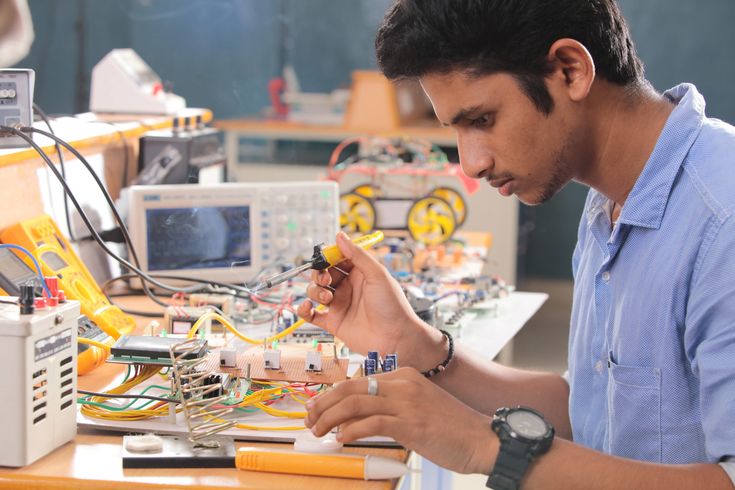Globalization has transformed the electrical engineering landscape, fueling unprecedented demand for skilled professionals across continents. As industries invest heavily in renewable energy, smart infrastructure, and advanced manufacturing, companies worldwide are seeking specialized talent to drive innovation and maintain competitive advantage. For many engineers, securing a role abroad requires navigating the complexities of visa sponsorship—a process that can seem daunting but ultimately opens doors to career growth, cultural immersion, and competitive compensation.
In this comprehensive article, we delve into the ecosystem of global visa-sponsored electrical engineering careers, offering actionable insights on market trends, visa application strategies, and practical tools to streamline your overseas job search. We’ll explore the rise of electrification projects—from wind farms and solar parks to electric vehicle charging networks—while examining how policy initiatives in different regions shape demand for power systems and control engineers. You’ll gain clarity on salary benchmarks across North America, Europe, and Asia‑Pacific, plus an overview of must-have certifications like the Professional Engineer (PE) license and Certified Energy Manager (CEM).
Answer Questions & Apply
Results
#1. What is your highest level of education?
#2. What type of opportunity are you most interested in?
#3. Do you have any work experience?
#4. Do you have a valid international passport?
#5. What is your current country of residence?
To help you navigate residency options, we also highlight the Work & Stay: Top Countries Offering Clear Paths to Residency with Visa Sponsorship guide, which outlines key programs designed to support international talent in achieving permanent status. By the end of this guide, you’ll have a clear roadmap to pursue and secure a visa‑sponsored electrical engineering position that aligns with your career ambitions and lifestyle goals. Whether you’re a recent graduate or a seasoned engineer, the insights here will empower you to make informed decisions and position yourself as a top candidate in a competitive global market.
The Growing Demand for Electrical Engineers Worldwide
In recent years, the push for decarbonization and digital transformation has accelerated demand for electrical engineers across diverse sectors. The renewable energy revolution, driven by government incentives and corporate sustainability goals, has led to rapid deployment of wind turbines, solar arrays, and energy storage systems. Simultaneously, the rollout of smart grids and Internet of Things (IoT) platforms has created opportunities in power systems analysis, grid resilience, and telemetry.
The telecommunications industry continues to expand its infrastructure footprint, investing billions in 5G networks and fiber-optic backbones. Electrical engineers with expertise in RF design, signal processing, and network optimization are in high demand to ensure seamless connectivity and low-latency performance. Moreover, the automotive sector’s shift toward electrification has sparked a surge in roles for power electronics specialists, battery management system developers, and embedded software engineers.
According to industry reports, the highest concentration of visa-sponsored engineering positions can be found in North America, Western Europe, and the Asia‑Pacific region. Governments in countries like Canada, Germany, and Australia have introduced streamlined visa pathways to attract talent, recognizing that foreign professionals bring critical skills that drive innovation and economic growth. For a comprehensive overview of these sectors and their sponsorship policies, refer to The Top 5 Industries Offering Visa Sponsorship Worldwide.
Beyond sector-specific trends, macroeconomic factors such as infrastructure stimulus packages, urbanization, and the electrification of transportation networks are contributing to sustained hiring across public utilities, manufacturing, and consulting firms. As projects become more complex and globalized, multinational corporations often turn to international recruitment to fill niche roles—making visa sponsorship an essential component of their talent acquisition strategy.
Navigating Visa Sponsorship Pathways
Securing visa sponsorship as an electrical engineer involves aligning your professional credentials with immigration requirements and employer needs. Typically, multinational companies and specialized engineering consultancies sponsor candidates through work visa programs that mandate a validated job offer, proof of qualifications, and a labor market assessment or equivalent. Understanding each country’s visa categories—such as the H‑1B in the United States, the Skilled Worker Visa in the UK, or the Temporary Skill Shortage (TSS) visa in Australia—is critical to tailoring your application.
In the UK, for example, the Skilled Worker Visa requires a sponsorship certificate from a licensed employer, a minimum salary threshold, and English language proficiency. Alternatively, professionals may explore family-based routes; the Step-by-Step Guide to the UK Marriage Visa in 2025 outlines how spouses of UK citizens or settled persons can secure a visa, potentially simplifying relocation for dual‑career couples.
Canada’s Express Entry system awards points for education, work experience, and language skills, with provincial nominee programs offering additional streams for in-demand occupations. In Germany, the EU Blue Card provides a fast track for non‑EU nationals earning above a specified salary threshold, while Singapore’s Employment Pass emphasizes specialized expertise and competitive remuneration.
Regardless of the destination, successful applicants must prepare comprehensive documentation: degree certificates, professional licenses, detailed CVs, and letters of recommendation. Proactively engaging with immigration consultants or in‑house HR teams can clarify submission deadlines and compliance requirements, ensuring your application is robust and timely.
Top Industries Embracing Visa‑Sponsored Electrical Engineering Talent
Electrical engineers find visa‑sponsored roles across a spectrum of industries, each offering unique challenges and growth trajectories. The energy sector remains a top employer, with power generation companies recruiting experts in grid modernization, renewable integration, and energy storage solutions. Telecommunication providers are equally active, seeking engineers to optimize network infrastructure, design base stations, and develop low-power IoT devices.
In the automotive industry, the electric vehicle (EV) revolution has created high demand for professionals specializing in power electronics, battery management, and vehicle control systems. Manufacturing and industrial automation companies also sponsor engineers to implement robotics, programmable logic controllers (PLCs), and advanced sensor networks on factory floors.
Consulting firms and research institutions present opportunities for engineers interested in project management, feasibility studies, and technology assessment. Even startups in the cleantech space offer sponsored positions for those passionate about innovation and sustainability.
For newcomers targeting entry‑level positions to gain Canadian experience, explore the Top 10 Easiest Jobs with Visa Sponsorship for Newcomers in Canada, which highlights accessible roles that can serve as stepping stones into specialized engineering careers.
Across these sectors, companies often bundle relocation assistance, visa processing support, and professional development programs into their compensation packages. This holistic approach not only attracts global talent but also fosters long-term retention and career advancement.
Salary Expectations and Benefits in Key Markets
Salaries for visa‑sponsored electrical engineers vary significantly by region, specialization, and experience level. In North America, entry-level engineers can expect base salaries starting at $70,000–$85,000 USD, with mid‑career professionals earning $90,000–$110,000 USD. Senior roles—particularly those in leadership or specialized fields like high‑voltage systems—can command over $120,000 USD annually, often supplemented by performance bonuses and stock options.
Europe offers competitive packages as well. In Germany and the Netherlands, mid-level electrical engineers typically earn between €55,000–€75,000 (≈$60,000–$82,000 USD), while in the UK, salaries range from £45,000–£65,000 (≈$57,000–$83,000 USD). Benefits often include health insurance, pension contributions, and flexible working arrangements.
In the Asia‑Pacific region, Australia’s Skilled Worker Visa positions pay around $70,000–$95,000 USD, with cost-of-living adjustments varying by city. Singapore’s Employment Pass holders can expect salaries of SGD 60,000–SGD 90,000 (≈$44,000–$66,000 USD), plus relocation allowances and housing stipends.
Beyond salary, financial planning resources are essential. For international professionals considering Canadian programs, the $40,000+ Scholarships in Canada for International Students (Apply Now!) can offset education costs and improve your financial profile prior to employment. Combining scholarship awards with employer-sponsored relocation packages can significantly reduce initial expenses and ease the transition into your new role. Additionally, many employers cover visa application fees, provide temporary housing stipends, and offer language training support to help you acclimate both personally and professionally.
Essential Qualifications and Certifications for Visa Approval
To stand out in a competitive global job market and satisfy visa requirements, electrical engineers should pursue both academic credentials and professional certifications. A Bachelor’s or Master’s degree in electrical engineering, power systems, or electronics forms the foundation. For roles in North America, obtaining a Professional Engineer (PE) license can be a decisive advantage, signaling verified competency to both employers and immigration authorities.
Specialized certifications—such as Certified Energy Manager (CEM) or Certified Automation Professional (CAP)—demonstrate expertise in niche areas like energy efficiency and industrial control systems. Telecommunications professionals may benefit from vendor-specific credentials, including Cisco’s CCNA/CCNP or Juniper’s JNCIA, which validate network design and maintenance skills.
For international students seeking financial assistance, integrating scholarships with loans can optimize your funding strategy. The How Student Loans Can Bridge Your Scholarship Funding Gap resource outlines approaches to combine debt financing with grants, ensuring you maintain financial stability while meeting education and visa prerequisites.
Continuous professional development—attending workshops, publishing technical papers, and participating in IEEE conferences—further enhances your profile. Demonstrating an ongoing commitment to learning not only boosts employability but also aligns with immigration criteria that favor candidates bringing innovative skills to host economies.
Key Resources and Opportunities
Midway through your career planning, it’s helpful to reference curated tables that consolidate visa pathways, financial resources, and job opportunities. Drawing on authoritative guides and sponsorship programs, these resources enable you to quickly identify relevant links, understand application steps, and evaluate financial and employment options. Use these tables to align your qualifications with visa criteria, compare funding and housing solutions, and pinpoint entry‑level roles with clear salary benchmarks—streamlining your overseas job search and ensuring you focus on opportunities that best match your goals and timeline.
Visa Pathway Guides
Whether you’re exploring work visas, family-based sponsorship, or residency pathways, these guides offer step-by-step instructions, eligibility criteria, and region-specific requirements to simplify your application process. They cover key programs in countries like Canada, the UK, Germany, and beyond—highlighting application timelines, minimum income thresholds, and documentation checklists so you can prepare a compliant and competitive submission.
| Guide | Focus Area |
|---|---|
| Step-by-Step Guide to the UK Marriage Visa in 2025 | UK marriage visa process |
| The Complete Guide to Securing a Visa Through Marriage | Global marriage-based visa |
| Work & Stay: Top Countries Offering Clear Paths to Residency with Visa Sponsorship | Country-specific residency paths |
| The Top 5 Industries Offering Visa Sponsorship Worldwide | Industry trends and sponsorship |
Financial Resources
Financing an overseas move often requires a combination of scholarships, loans, and cost‑saving strategies. These resources showcase high‑value scholarships, loan options, affordable temporary housing, and travel deals that include visa sponsorship perks—empowering you to minimize out‑of‑pocket expenses and maintain financial stability during your transition. Review eligibility criteria, application deadlines, and benefit details to secure funding that complements employer-sponsored relocation packages and supports your living costs abroad.
| Resource | Key Benefit |
|---|---|
| $40,000+ Scholarships in Canada for International Students (Apply Now!) | Generous scholarship funding |
| How Student Loans Can Bridge Your Scholarship Funding Gap | Loan options to supplement scholarships |
| Affordable Temporary Housing Options for Visa Holders | Budget-friendly accommodation |
| Get Paid to Travel: Flight Deals to Canada Including Free Visa Sponsorship Perks | Travel deals with sponsorship perks |
Job Opportunities
For professionals seeking immediate employment with visa support, this table lists accessible roles in sectors like agriculture, logistics, hospitality, and skilled trades. Each position comes with clear salary expectations, enabling you to assess entry‑level or transitional opportunities that build local experience, enhance language skills, and create a pathway toward specialized electrical engineering roles.
| Job Title | Salary Expectation (USD) |
|---|---|
| Top 10 Easiest Jobs with Visa Sponsorship for Newcomers in Canada | $30,000 – $45,000 |
| No Experience Needed! Fruit Picker & Farm Work Jobs in Canada with Visa Support | $18,000 – $25,000 |
| Delivery Driver Jobs with International Visa Sponsorship | $30,000 – $45,000 |
| Chef and Cook Positions with Visa Sponsorship (Apply Today!) | $35,000 – $50,000 |
| Kitchen Porter & Dishwasher Jobs Offering Visa Support | $22,000 – $28,000 |
| Tailoring & Seamstress Jobs Offering Visa Sponsorship | $25,000 – $35,000 |
Regional Spotlight: North America, Europe, Asia‑Pacific
North America
Canada and the United States remain top choices due to robust R&D ecosystems, competitive salaries, and well-established sponsorship pathways. In Canada, the Express Entry and Provincial Nominee Programs (PNPs) prioritize skilled engineers, awarding points for education, work experience, and language proficiency. The United States H‑1B visa, though capped annually, continues to attract specialized talent for roles in power systems design, automation, and semiconductor research.
Major tech hubs—such as Toronto, Vancouver, San Francisco, and Austin—offer clusters of innovation in renewable energy startups, smart grid development, and EV charging infrastructure. Companies often provide relocation packages that include temporary housing stipends, settling‑in allowances, and visa fee reimbursement. For budget‑conscious newcomers, the Affordable Temporary Housing Options for Visa Holders guide outlines cost‑effective accommodation solutions near key engineering centers, helping you secure short‑term rentals while you finalize permanent arrangements.
Beyond compensation, North America’s multicultural workplaces, professional networking events, and strong emphasis on continuing education make it an ideal launchpad for global careers. Engineers benefit from access to industry conferences, university partnerships, and government grants, reinforcing both technical expertise and local credibility.
Europe
Europe presents diverse markets, each with unique visa frameworks and engineering demands. Germany’s EU Blue Card offers a streamlined route for non‑EU nationals earning above €58,400 annually (or €45,552 in shortage occupations), making it attractive for power electronics and automation specialists. The UK’s Skilled Worker Visa, updated in 2024, emphasizes roles in digital infrastructure and green energy, with a minimum salary threshold of £38,700. Countries like France, the Netherlands, and Sweden also sponsor engineers, particularly in renewable integration and telecommunications.
European employers often provide comprehensive benefits—healthcare coverage, pension contributions, and professional development budgets—while emphasizing work‑life balance through flexible schedules and generous leave policies. Multilingual environments encourage language training, with many companies offering in‑house courses to support integration. Additionally, proximity to EU research grants and cross‑border collaborations enables participation in large‑scale projects, from offshore wind farms in Denmark to 5G testbeds in Finland.
Asia‑Pacific
Asia‑Pacific markets such as Australia, Singapore, and Japan are investing heavily in smart grid technology, EV infrastructure, and industrial automation. Australia’s TSS visa (subclass 482) targets engineers with competitive salaries and points‑based assessments, while Singapore’s Employment Pass favors professionals earning SGD 4,500+ monthly. Japan’s Highly Skilled Professional visa accelerates permanent residency for individuals with advanced degrees and specialized skills.
Companies in these regions often offer generous relocation allowances, housing support, and language classes. The vibrant tech ecosystems—ranging from Sydney’s renewable research centers to Singapore’s smart city initiatives—provide fertile ground for electrical engineers seeking to contribute to high‑impact, future‑focused projects.
Crafting a Standout Application for Visa‑Sponsored Roles
Crafting an application that appeals to both employers and immigration authorities requires attention to detail and strategic presentation of your credentials. Begin by tailoring your resume to highlight relevant projects, quantifiable achievements, and specialized skills. For electrical engineers, emphasize experience with power system simulations, control algorithm development, or hardware prototyping. Use industry‑standard metrics—such as percentage improvements in energy efficiency or cost savings—to demonstrate impact.
In your cover letter, articulate your understanding of the host country’s regulatory environment and industry trends. For instance, reference the global shift toward grid decentralization or the adoption of smart meters to show you’re aligned with employer objectives. If you’ve participated in international collaborations or remote teams, showcase your cross‑cultural communication skills and adaptability.
When applying, ensure all academic transcripts, certification documents, and reference letters are officially translated and authenticated according to destination requirements. Many companies have designated HR portals for visa‑sponsored roles; complete each section thoroughly, double‑checking visa‑related fields like nationality, language proficiency scores, and intended start dates.
Leveraging professional networks—such as LinkedIn groups, IEEE chapters, or alumni associations—can provide insider referrals and company‑specific tips. Engaging with recruiters who specialize in sponsored positions may yield early insights into job openings and expedite the application process.
Finally, prepare a concise portfolio or personal website featuring project summaries, technical whitepapers, and code repositories if applicable. A well‑organized portfolio not only showcases your expertise but also serves as a dynamic supplement to static documents, reinforcing your candidacy in a competitive global job market.
Interview Tips and Cultural Considerations
Securing an interview for a visa‑sponsored position is a major milestone, but excelling in the interview requires thorough preparation and cultural sensitivity. Begin by researching the company’s mission, recent projects, and organizational structure. Familiarize yourself with their engineering standards, software toolchains, and quality assurance protocols to tailor your responses to real‑world challenges they face.
Technical interviews often include problem‑solving sessions, whiteboard exercises, or live coding for embedded systems. Practice common electrical engineering scenarios—such as designing a PID controller, troubleshooting a three‑phase power imbalance, or optimizing a PCB layout under cost constraints. Use online platforms or study groups to refine your approach and receive feedback.
Behavioral interviews assess teamwork, leadership, and adaptability. Prepare STAR (Situation, Task, Action, Result) stories that illustrate how you’ve navigated complex projects, resolved conflicts, or implemented process improvements. Emphasize examples where you collaborated with cross‑functional teams or mentored junior engineers.
Cultural norms vary: North American interviews may encourage open dialogue and direct feedback, while European contexts can be more formal and hierarchical. In Asia‑Pacific regions, showing respect for seniority and demonstrating humility can be key. When in doubt, observe the interviewer’s tone and mirror appropriate levels of formality.
Finally, ask thoughtful questions that reflect genuine interest—such as the team’s preferred engineering methodologies, opportunities for international secondments, or company‑sponsored certification programs. Engaging in a two‑way dialogue underscores your commitment to both technical excellence and long‑term cultural fit.
Long‑Term Career Growth and Path to Permanent Residency
While initial visa sponsorship secures your entry into a global engineering role, planning for long‑term career growth and permanent residency is equally important. Many countries award points or priority to individuals with sustained work experience under employer sponsorship. For instance, Canada’s Express Entry system grants additional points for time spent in Canada, while Australia’s General Skilled Migration program recognizes years of professional practice and advanced qualifications.
Continuing education plays a pivotal role: pursue specialized master’s programs, industry‑recognized certifications, or executive leadership courses to strengthen your profile. Employers may sponsor these programs or reimburse tuition, particularly for skills critical to organizational strategy. Publishing technical papers or filing patents can further demonstrate your contribution to the host country’s knowledge economy.
Networking within professional associations—such as IEEE, IET, or local engineering societies—expands your visibility and can lead to invitations to speak at conferences or participate in government‑industry panels. Such engagements not only bolster your resume but also provide evidence of your integration into the local engineering community.
Maintaining strong performance reviews, seeking internal promotions, and mentoring junior staff can accelerate eligibility for permanent residency. Some countries allow transition from temporary work visas to permanent status through employer‑nominated streams, highlighting the value of building long‑term relationships with your sponsoring organization.
Finally, monitor changes in immigration policies and engage with legal or immigration experts to adapt your strategy. By proactively aligning your career trajectory with residency criteria, you’ll ensure a smoother pathway from sponsored engineer to permanent resident—unlocking benefits such as family sponsorship, homeownership, and access to public services.
Conclusion
As global economies pivot toward sustainable energy, digital infrastructure, and automation, electrical engineers with international experience are more valuable than ever. Securing a visa‑sponsored role offers not only competitive compensation and professional development but also the opportunity to immerse yourself in diverse cultures and work on groundbreaking projects. By understanding market trends, preparing meticulously for visa applications, and leveraging curated resources, you position yourself as an ideal candidate for employers worldwide.
This guide has outlined the key steps to pursue global visa-sponsored electrical engineering careers: identifying high-growth industries, assessing salary expectations, obtaining critical certifications, and navigating country-specific visa pathways. We provided three comprehensive tables—Visa Pathway Guides, Financial Resources, and Job Opportunities—to serve as quick references during your job search. Additionally, regional spotlights highlighted unique benefits and challenges in North America, Europe, and Asia‑Pacific, equipping you to select the best-fit destination for your professional goals.
Remember, success hinges on continuous learning, proactive networking, and strategic planning for long-term residency. Tailor your applications with quantifiable achievements, practice technical and behavioral interviews, and engage with professional communities to amplify your visibility. Whether you’re designing smart grids in Germany or automating manufacturing lines in Singapore, the roadmap to a fulfilling overseas career is within reach.
Start by bookmarking the guides and tables most relevant to your aspirations, then set clear milestones for qualification, application, and relocation. With diligence and the right resources, you can unlock a world of opportunity as a visa‑sponsored electrical engineer—powering innovation across borders and advancing your career on the global stage.










